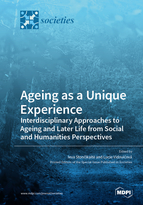Ageing as a Unique Experience: Interdisciplinary Approaches to Ageing and Later Life from Social and Humanities Perspectives
A special issue of Societies (ISSN 2075-4698).
Deadline for manuscript submissions: closed (30 June 2022) | Viewed by 51770
Special Issue Editors
Interests: cultural gerontology; senior tourism and leisure; social innovation related to active and healthy ageing research
Special Issue Information
Dear Colleagues,
Ageing is a diverse and multifaceted experience that is unique to each person. The process of ageing is lived differently according to each individual’s socio-cultural, historical, and political context, among other factors. However, the stereotype of homogeneity is still one of the strongest aspects related to later life. This Special Issue invites manuscripts of original research to critically explore the experience of old age and the process of growing old from the social sciences and/or humanities perspectives. It opens space for topics related to social gerontology, social anthropology, age and gender studies, body politics, sexuality, active and healthy ageing, cultural and literary gerontology, and other related disciplines. This call seeks to collect arguments that show the variables and uniqueness of later life, and we welcome contributions that expand on the current theoretical frameworks in the field of age studies overall. The overall aim of this Special Issue—“Ageing as a Unique Experience: Interdisciplinary Approaches to Ageing and Later Life from Socio-cultural and Humanities Perspectives”—is to offer a collection of articles that can broaden the scholarship and develop critical thought of old age and the life course to contribute to the current and future dialogue on the unique experiences of ageing.
Dr. Ieva Stončikaitė
Dr. Lucie Vidovićová
Guest Editors
Manuscript Submission Information
Manuscripts should be submitted online at www.mdpi.com by registering and logging in to this website. Once you are registered, click here to go to the submission form. Manuscripts can be submitted until the deadline. All submissions that pass pre-check are peer-reviewed. Accepted papers will be published continuously in the journal (as soon as accepted) and will be listed together on the special issue website. Research articles, review articles as well as conceptual papers are invited. For planned papers, a title and short abstract (about 100 words) can be sent to the Editorial Office for announcement on this website.
Submitted manuscripts should not have been published previously, nor be under consideration for publication elsewhere (except conference proceedings papers). All manuscripts are thoroughly refereed through a double-blind peer-review process. A guide for authors and other relevant information for submission of manuscripts is available on the Instructions for Authors page. Societies is an international peer-reviewed open access monthly journal published by MDPI.
Please visit the Instructions for Authors page before submitting a manuscript. The Article Processing Charge (APC) for publication in this open access journal is 1400 CHF (Swiss Francs). Submitted papers should be well formatted and use good English. Authors may use MDPI's English editing service prior to publication or during author revisions.







